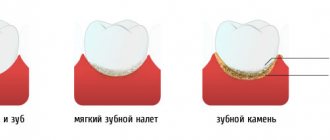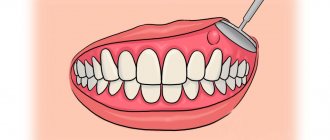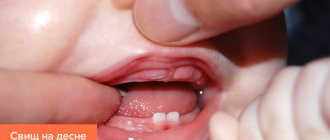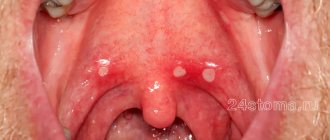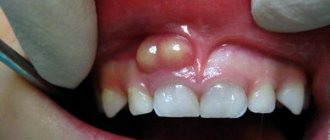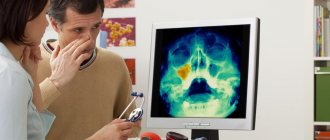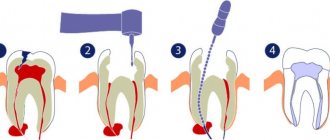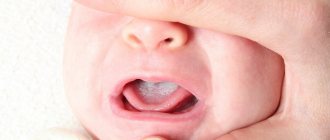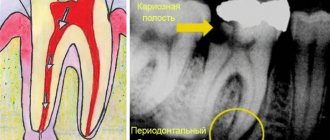A cyst on a child’s gum is a very common pathology that is regularly reported by many parents. This formation occurs as a result of an inflammatory process caused by an infection in the oral cavity.
In fact, it is a microabscess, not a cyst. However, this designation has been fixed in medical sources.
The main reason is that the area of inflammation is limited to the fibrous capsule, giving the pathological structure a truly cystic structure.
What it looks like and why it is dangerous
A cyst on the gum is visualized as:
- hyperemic swelling resembling a pea;
- sometimes whitish or yellowish spots can be seen on the swelling when the neoplasm is abundantly filled with purulent contents;
- neoplasm with uneven edges, varies greatly in size and color, from very small to 15 mm in diameter, from pale pink to bright red;
- if a small white tubercle (up to 3 mm) is detected, then this is most likely a Bohn's node - a type of cyst, formed from the residual epithelium of the salivary gland, very similar to Epstein's pearls (which are located on the palate), almost always resolves in the first months of life.
The most typical locations for such pathologies are the gums of molar teeth. The infection is just a side, triggering factor of the disease, and the key is psychosomatics, disturbances in it.
Children with cysts on the gums often experience psychoneurological problems and gastrointestinal diseases, which make the child emotionally unstable and restless.
What type of spots can pose a danger to a newborn?
Not always spots on a baby’s gums can be caused by relatively harmless reasons. That is why it is important not to leave the problem unattended, even if there are no signs of concern.
If you notice a deviation from the usual appearance of children's gums, you should consult a doctor:
- Periodontitis appears as white or clear blisters. Due to the fact that the baby puts everything in his mouth, they can burst, and an infection will enter the fragile body, then a purulent pimple will appear, and the infection threatens to spread further.
- Thrush manifests itself in the form of a white coating on the gums and tongue, the wounds underneath cause significant discomfort, because of this the baby may completely refuse to eat. To avoid this, it is necessary to undergo antifungal therapy, give the baby water, and also walk in the fresh air.
- Due to infection in the body, cysts can form on the gums. It is quite difficult to diagnose; an accurate diagnosis can only be made on the basis of x-rays.
- Wen is a relatively harmless disease, but it causes discomfort to the child, so, as a rule, the doctor decides to remove it.
- A gum tumor with a white head looks like a lump or cyst, but there may be cancer lurking inside. Any tumor should be immediately examined by a specialist.
Read also: Abatman for implantation
Kinds
Based on which gum the cyst is located on, there are:
- molar cysts;
- wisdom tooth cyst;
- canine neoplasm;
- pathology of the front tooth (incisor).
Despite the common cause of exposure to an infectious pathogen, this disorder is divided into scenarios of occurrence.
The cyst may be:
- follicular (dental) - formed when a pathogen enters an unerupted tooth germ;
- radicular - occurs as a complication of periodontitis during chronic course of the latter (periodontitis - inflammation of the connective tissue that holds the tooth in the alveolus);
- retromolar (paradental) - if the third molars (wisdom teeth) are cut for a long time and with difficulty, pathogenic bacteria often penetrate into the damaged tissue, and a focus of inflammation develops;
- primary or keratocyst - is a true cyst, since it arises from what remains of the dental tissue during tooth formation;
- eruption cyst - often observed when baby teeth are replaced by permanent ones (i.e. in children aged 6-11 years), often resolves spontaneously;
- residual - a common form that occurs as an infectious complication after tooth extraction;
- the most common is carious, which occurs as a result of a chronic focus of infection in the area of carious tooth decay.
Several varieties can be diagnosed simultaneously.
Cyst or tumor of the jaw in a child: when is it time to sound the alarm
A dental cyst in a child is by no means a rare occurrence among young patients. The most common reasons for its appearance, experts include maxillofacial injuries, poor quality of dental treatment and infection. The trouble is that a milk tooth cyst can have a detrimental effect on the formation of the rudiments of permanent teeth. What it is and how the disease can be cured will be discussed further.
Stages of development of formations on the gums
It is no coincidence that the full stages of formation of the described pathological structure are noted in childhood (from infancy to 12 years).
In adults, a gum cyst may not manifest itself in any way for many years.
The peculiarities of the development of cysts in the gums in children are explained by the characteristics of their immune system. Children's immunity has not yet come into contact with most of the main infectious agents. It is not fully formed. And at the same time, it is distinguished by a high level of sensitization, that is, it reacts violently even to a small amount of the pathogen.
Adult immunity successfully suppresses inflammation in the oral cavity without causing symptoms.
In children, a fibrous capsule begins to form around the lesion - this is a natural reaction of the body when the area of inflammation is sufficiently pronounced.
- Initial stage. — In infants, the initial stage of the disease is already clearly visible. — Inflammation of the periodontium, pulp or apex of the tooth root is manifested by pain: the child constantly cries, screams, sleeps poorly, eats poorly. — In a newborn, the gums can become inflamed spontaneously, without a visible prior source of infection.
- Progressive stage. — As the disease progresses, you can already notice swelling on the gums. — It is typical that sometimes at this stage the pain syndrome decreases. It is not known exactly what this is connected with: migration of the inflammation focus to the cyst area, gradual death of the tooth nerve as a result of chronic inflammation.
- When the process is running. — If no measures are taken, the inflammation becomes purulent. — Suppuration of a cyst is an extremely undesirable phenomenon, since it puts a serious immune and toxicological burden on a fragile organism.
Consequences
Without adequate treatment, the dental cyst continues to grow and develop; in advanced stages, large neoplasms destroy the bone tissue of the skull, as a result it is replaced by connective tissue formations, which leads to the development of the following complications:
- dissolution of the jaw bone, which depends on the growth of the cyst;
- the formation of pus in the cyst, further purulent inflammation can lead to the development of an abscess;
- inflammatory process of lymph nodes located near the source of infection;
- development of osteomyelitis or periostitis;
- development of chronic sinusitis when the cyst grows in the maxillary sinus;
- pathological fracture of the jaw bones when the cyst reaches a large size;
- development of phlegmon due to a long-term purulent inflammatory process in the cyst;
- sepsis – blood poisoning;
- degeneration of a cyst into a malignant tumor without timely treatment.
Many patients are interested in why a dental cyst appears in the maxillary sinus, how dangerous it is and its symptoms. The formation of a cyst of this type occurs as a result of untreated inflammation of the tooth root in the upper jaw. A granuloma forms at the root of the tooth, which increases in size and becomes a peri-radicular cyst, then takes a position in the maxillary sinus. The volume of such a cyst can reach 9-12 cubic centimeters.
The symptomatic picture includes painful sensations, the nature of which is similar to trigeminal neuralgia, pain in the occipital, temporal and parietal regions of the head. Externally, a dental cyst can be identified by the asymmetry of the face. Tooth cyst - photo shows a cyst in the maxillary sinus.
Causes of cysts in childhood
This pathology arises as a result of a list of specific diseases or temporary physiological processes:
- caries, which destroys the enamel and reaches the dentin, provokes pulpitis and, accordingly, gum disease;
- The occurrence of cysts is further promoted by rarer internal caries, which begins to act from the root of the tooth;
- chronic periodontitis - inflammation of the connective tissue root membrane of the teeth and adjacent tissues;
- the focus of inflammation is not necessarily associated with the teeth - such a cyst occurs against the background of sinusitis, sinusitis, tonsillitis, especially if these pathologies have become chronicled;
- various diseases of the tongue, which are often observed in patients with a gastrointestinal tract, anemia, autoimmune processes, allergic reactions;
- severe trauma and poor-quality sanitation after tooth extraction increases the risk of cystic formation (this also includes poor-quality filling, and ordinary tooth trauma from an impact or fall);
- Children may experience pain when teething, which forces them to touch their mouths with their hands, and this is one of the sources of infection;
- The described pathological structures can appear when changing baby teeth, since after the loss of a baby tooth a bleeding wound inevitably remains.
The root cause is always the same - viral and bacterial infection. But, as a rule, it has a bacterial etiology. This means it is more dangerous, because the bacterium provokes a purulent process.
Reasons for the appearance of white spots on the gums of a baby
White spots and pimples on the gums of infants are a cause for concern, because they can be caused by either harmless reasons or be a sign of disease.
In order not to miss an alarming symptom, you need to examine the child’s skin and mucous membranes every morning. This way you will notice problems in the baby’s body as soon as they appear and can begin treatment. Particular attention should be paid to the gums: the child tries everything that comes to hand and can damage the delicate oral cavity. Healthy gums are pink, smooth, and if you suddenly notice white spots, wen, cysts, pimples, then this is a reason to show your baby to the doctor.
Stomatitis and other inflammations
Stomatitis develops when there are any disorders in the baby’s body and for no apparent reason. This is a mucosal disease in which the gums and tongue become covered with ulcers, bumps and white spots. The baby shows signs of anxiety, cries, and it hurts to suck the breast or bottle. Sometimes an elevated body temperature appears, but this is not a necessary symptom.
Stomatitis occurs due to a lack of iron, other vitamins and microelements in the body, lack of folic acid, stress due to weaning or other reasons. A viral, fungal or bacterial infection can also contribute to the development of the disease. The disease should not be neglected and at the first suspicion, consult a dentist.
Neonatal teeth
In rare cases, a child is born with congenital teeth.
They look like tiny white balls along the gums, and a baby with this feature should be shown to a doctor. If it turns out that the teeth are not one of the 20 primary teeth, they will have to be removed to avoid future crowding. Neonatal teeth, which appear from 1 to 3 months of life, also look like white spots, they need to be monitored by a specialist, and if it turns out that they are not milk teeth, they must be removed.
Benign neoplasms are cysts, they go away without additional intervention, but still require medical supervision, since some of them can develop into ulcers over time. They usually appear due to infection of the infant's oral cavity.
Another type is Epstein's pearls; these neoplasms are also cysts and usually go away without medical help. They look like pearl oysters and do not pose any danger; they go away on their own over time.
Calcium deficiency
If the baby is breastfed, due to the lack of nutritional value of mother's milk, he may experience calcium deficiency. Nutritional value can decrease for various reasons, among which the first place is the mother’s poor diet. In this condition, white plaque is the only symptom of the disease, the baby does not show anxiety and behaves normally, but he may also show other signs of calcium deficiency - poor weight gain, lack of hair growth on the back of the head, etc.
Other reasons
White pearls and plaque in the baby's mouth may appear due to insufficient oral hygiene. A young mother should know that if she has no teeth, her tongue and gums need to be taken care of. To do this, you can wrap a piece of gauze around your finger or use a special silicone brush.
Another reason may be the lack of vitamins that the baby receives from mother's milk. If he is bottle-fed, formula may not be suitable for him. In any case, you need to consult a general practitioner, he will tell you what measures need to be taken.
Obvious symptoms
A cyst in the gum often shows its symptoms already in the second stage. Despite the sensitization of children's immunity, the disease can proceed covertly for some time.
It is worth paying attention to the following manifestations:
- hyperemia and swelling are regularly recorded on the gum or gums;
- the child complains of pain when biting (the pain can be typical dental, or reminiscent of the pain syndrome due to periodontal disease);
- periodic spontaneous occurrence of pain in the jaw area without the ability to accurately localize it;
- over time, inflammation of the gums intensifies, a characteristic tubercle is formed, often having a bluish tint;
- it is not difficult to notice whitish or yellowish spots on the tubercle - the purulent contents are visible;
- with further development, a fistula is formed, through which the outflow of pus occurs; the fistula is not always noticeable visually, but its presence is indicated by protruding pus when pressing on the gum.
Systemic manifestations include:
- general weakness;
- evening low-grade fever;
- decreased appetite;
- headache;
- enlargement of the cervical and submandibular lymph nodes, pain on palpation.
But this is typical for a mature cyst, which in the future, in the absence of proper treatment, risks developing into a gumboil or fistula.
Preventing the appearance of white spots in the mouth of a newborn
As you know, prevention is better than cure, so parents should take measures to ensure that the baby’s mouth remains smooth and pink, and the gums do not turn white, and no symptoms bother him:
- The child needs to be provided with all the necessary vitamins. If he is on breastfeeding, then the mother should improve her diet and give up bad habits.
- Watch for toys and other objects that your baby puts in his mouth. They should not have sharp parts that could damage the delicate mucous membrane.
- Maintain hygiene. Treat toys from the store before giving them to your child, do not lick a fallen pacifier, but rinse it with boiled water, and wash your hands before contacting the baby.
- Do not allow people with oral health problems to kiss the newborn.
Diagnostics
Diagnosis in this case consists of an initial clinical examination, when the dentist monitors the patient’s oral cavity.
And the main point is a detailed radiography of the lower or upper (depending on the location of the formation) jaw. X-rays can accurately determine the type of cyst.
In some cases, a biopsy may be taken, sampling the biomaterial of the cyst to study its cellular morphology.
Methods of therapy
Dentistry and, in some cases, facial surgery are used to eliminate cysts on the gums.
As in all other cases of treatment, there are:
- conservative;
- surgical.
Conservative treatment is implied if the formation is up to 10 mm in size and no serious complications have arisen.
Even if the cyst resolves spontaneously or bursts, treatment is still required. After all, if you leave everything as it is, there is a high probability of a relapse.
Conservative treatment
Currently, conservative therapy is carried out using two methods:
- Since new growth is almost always associated with advanced caries, the dentist's first task is to clean the root canal. — The cyst cavity connects to the inflamed root. — The tooth is drilled, the canal is cleaned, and washed with antistatic solutions. - Then bactericidal and lysing agents are added, which neutralize the pathological contents of the cyst. — At the final stage, substances that promote osteogenesis are loaded into the cleaned cavity. — These drugs provide care and recovery. — Then the tooth is filled. — After six months, it is necessary to take a control X-ray, which is necessary to check the quality of the filling and prevent the development of a new cyst. — The effectiveness of the described conservative therapy is about 70%.
- Today, a more modern method is increasingly being used - depophoresis, the effectiveness of which is much higher, 95%. — Its difference is that copper-calcium hydroxide is placed into the drilled channel, and then an electric current is applied to the tooth. — Copper and calcium ions, under the influence of an electromagnetic field, penetrate into all tooth canals and into all parts of the cyst cavity, producing a powerful disinfecting effect. — And even after the filling is placed, the hydroxide still acts as a bactericidal agent for some time.
The choice of method is determined strictly individually.
Surgery
Surgical removal of a cyst on the gum is important for:
- large size of the formation, more than 12 mm;
- ineffectiveness of conservative therapy;
- repeated relapses.
Surgical treatment has three options:
- Cystectomy. - It is carried out in most cases. — The operation consists of removing the cyst and the affected part of the root. “At the same time, there remains a good chance to save the tooth itself.
- Cystomy. — A puncture is made in the gum tissue. — It is even easier to puncture a cyst if it is clearly visualized. — The puncture allows you to efficiently pump out the purulent contents. — Such intervention is relevant when the cyst is large and there is a large purulent focus.
- Hemisection. — It is used only for advanced, large lesions, when inflammation has begun to spread to neighboring tissues. — Essentially, a fairly large area of gum with the remains of a decayed tooth is removed here. — Subsequently, dentures are required.
The first two intervention options are performed under local anesthesia and almost never require hospitalization. The third option is depending on the severity of the disease.
ethnoscience
It is possible to cure a cyst on the gum while remaining at home, quickly and reliably, only in the very early stages of the development of the disease.
But this is not always possible due to the asymptomatic onset of the pathology.
Rinse solutions
A well-known and affordable option of traditional medicine is to treat the oral cavity with rinses.
All products for preparing rinses can be easily purchased at your nearest pharmacy.
Examples of recipes (it is recommended to use boiled water):
- sea water - 200 ml of warm water, a teaspoon of baking soda, a pinch of table salt and a couple of drops of an alcohol solution of iodine;
- Dissolve Nitrofural (Furacilin) tablet in 200 ml of warm water;
- add 1-2 teaspoons of calendula in alcohol to 200 ml of water;
- similarly, you can add a few drops of Fukortsin (Castellani liquid);
- Thoroughly dissolve several crystals of potassium permanganate (potassium permanganate) in 200 ml of water (it is important to make sure that the crystals are completely dissolved so as not to burn the oral mucosa).
All rinsing is carried out according to 3 rules:
- rinse at least 3 times a day;
- after rinsing, do not eat or drink anything for at least 20 minutes;
- Carefully move each portion of the solution in your mouth for at least 10 seconds.
If a child is allergic to some remedy, it can be replaced with a herbal decoction: chamomile, St. John's wort, multi-herbal mixture.
Lotions and compresses
For very young children (under 3 years old), rinsing procedures can be a problem. In this case, the analogue is lotions and compresses.
If lotions are applied directly to the affected area of the gums, then compresses can be applied to the surface of the jaw (to improve the general condition).
It is recommended to use herbal decoctions as a solution for lotions and compresses.
Compresses made from fresh cabbage, boiled or freshly grated potatoes help:
- apply a fresh cabbage leaf to the jaw and wrap it with a bandage;
- Place boiled or grated potatoes in a bandage and secure it to the jaw.
Alcohol tinctures
To treat cystic formation, alcohol tinctures are sometimes used. Alcohol tincture of calendula has already been mentioned.
Vodka compresses are very popular in folk medicine. But since we are talking about children, alcohol tinctures are not recommended.
Natural oils
Natural oils are used for applications to the affected gums.
Oils have an anti-inflammatory, absorbable effect and improve the microflora of the oral cavity.
Apply: sesame, clove, lemon, almond, eucalyptus oils.
Application:
- soak a cotton pad or swab and apply it to the gum for 15 minutes;
- then the mouth must be rinsed with warm water.
How to help a child at home with suppuration?
If suppuration and the formation of a lump on the gum appear, it is recommended to contact a dentist as soon as possible, but, unfortunately, for various reasons this is not always possible.
If an adult can endure pain (although, of course, situations are different), then it is much more difficult for a child to endure painful sensations, and it is not easy for parents to watch their child suffer. There are ways to alleviate the baby's condition. Naturally, they will not replace full-fledged treatment, so you can resort to them only in situations where going to the doctor is impossible right now.
These include:
- take as much warm liquid as possible, which reduces intoxication of the body;
- eat liquid food (moderately warm, but not hot!), as it injures already damaged gums;
- If the pain becomes severe, you can use painkillers. For example, Nurofen or Paracetamol - the exact dosage depends on the age of the child, so before use you should carefully read the instructions for the drug;
- to reduce swelling, you can resort to cold - any frozen product from the freezer compartment of the refrigerator is wrapped in a soft cloth and applied to the cheek;
- use rinsing solutions that temporarily relieve pain - chamomile decoction or the drug chlorhexidine, which reduces irritation.
Possible complications
Since patients are still pre-pubescent, an untreated or undertreated cyst in the gum of a tooth can have the following consequences:
- the focus of purulent inflammation can spread to neighboring tissues. The infection can penetrate, first of all, into the palatine tonsils, triggering the onset of a purulent sore throat;
- the constant presence of infection keeps the sensitized immune system in an even more tense state. This can provoke the development of allergic reactions, and even worse, the development of autoimmune reactions;
- a chronic focus of bacterial infection attacks the heart, pericarditis or myocarditis may occur;
- a large cyst disrupts the position of the tooth; permanent teeth may erupt incorrectly, and this will lead to disturbances in diction.
Sometimes less serious, temporary complications occur:
- gum pain after cyst removal;
- secondary infection occurs.
These phenomena can be relieved by taking analgesics, local disinfection, and sometimes a short course of antibiotics.
Prevention at a young age
The main prevention of such a disease is oral hygiene.
- regular teeth cleaning;
- You should rinse your mouth with regular running water throughout the day, especially after eating sweet and sour foods;
- Hypoallergenic toothpaste is recommended, and a toothbrush with a hardness no higher than medium.
We must remember that healthy gums also need to be taken care of.
Elimination of white pimples on baby's gums
Treatment of a newborn’s gums is a set of measures, the most important of which is making a correct diagnosis. In some cases, a visit to the dentist is not enough. If your doctor suspects that gum problems are a symptom of an internal organ disease, he will order tests, including blood tests, and recommend visits to specialist doctors.
Drug treatment
The famous pediatrician Evgeny Komarovsky is deeply convinced that problems with the oral cavity are a reason to see a doctor, you should not self-medicate, a visit to a therapist is necessary.
If white pimples are caused by a disease of any organ, gum treatment is carried out in conjunction with eliminating the underlying cause. In the case where neoplasms on the gums arose due to internal pathology, first of all, you should find out the reason that gave rise to such symptoms. In accordance with the diagnosis, the following treatment is prescribed:
- pain relievers, antiviral/antifungal agents;
- rinsing with an antiseptic solution;
- drink plenty of fluids to avoid dehydration;
- antibiotics are prescribed in case of infection of the oral cavity by bacteria;
- in case of high temperature, antipyretics are prescribed;
- if the disease has become chronic, complex treatment is prescribed;
- Special attention should be paid to hygiene.
Folk remedies
Along with the treatment prescribed by the doctor, you can use traditional medicine recipes. However, many of them may not be suitable for the child and cause allergies, at the first manifestations of which you should stop using the product! The following have proven the most effective:
- treatment with liquid honey or propolis;
- calendula decoction: the herb is infused in boiling water, then you can rinse or wipe your mouth with it;
- if the purulent pimples are large and cause concern to the baby, it is recommended to treat the gums with an infusion of chamomile or calendula in combination with linden;
- harmless but effective treatment with hydrogen peroxide;
- lubricate your mouth with yarrow juice and honey.
